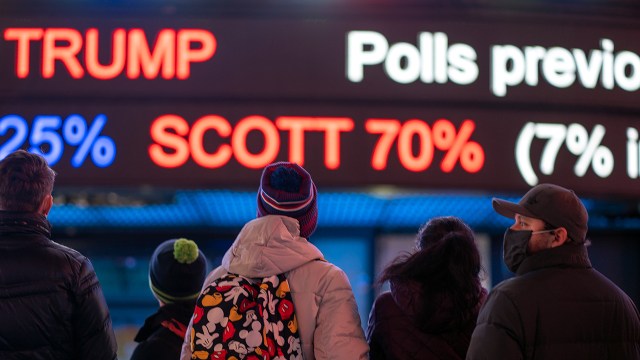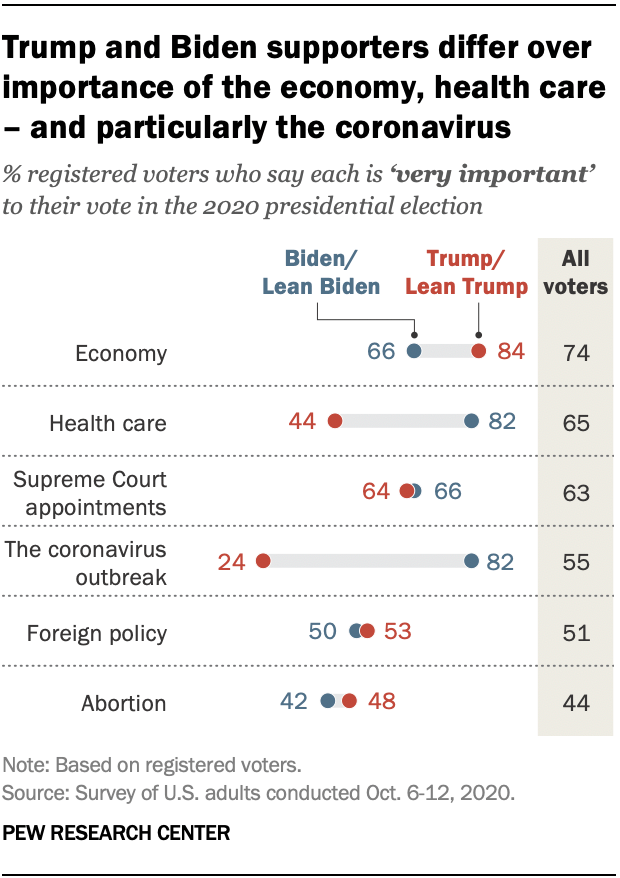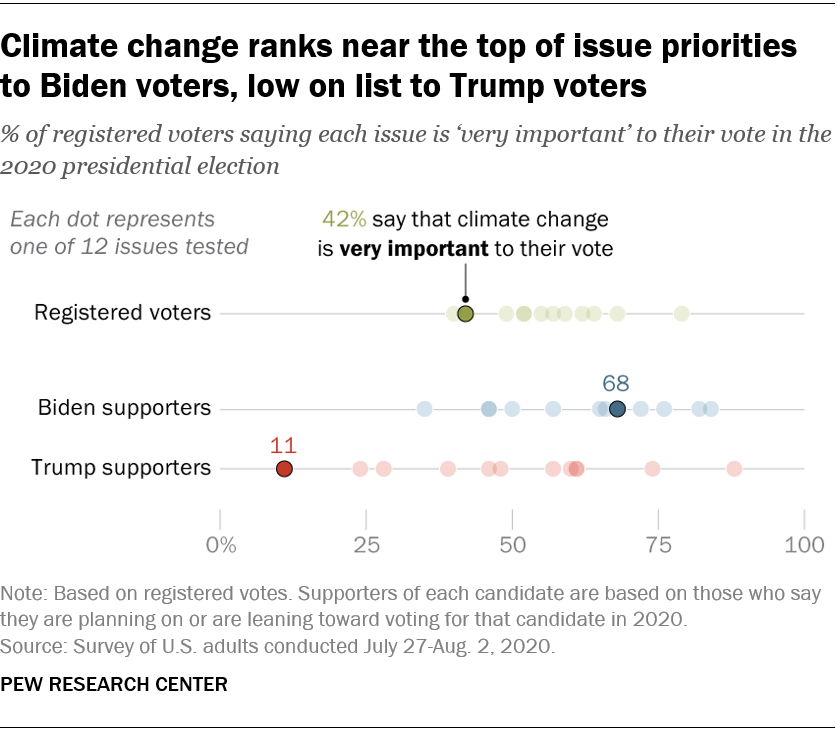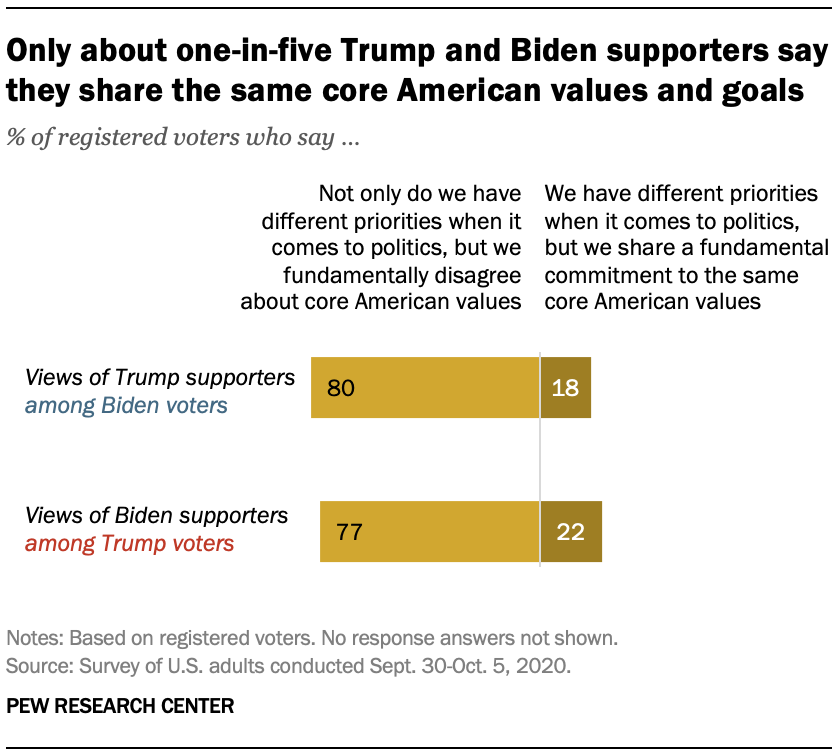
Even before all the ballots are tallied, Americans appear to have voted in the 2020 presidential election at their highest rate in 120 years. Democrat Joe Biden has amassed more than 74 million votes as of Nov. 6, while Republican Donald Trump has received nearly 70 million – already the most and second-most in U.S. history.
But if one early takeaway from the election is historic voter participation, another may be the continuing political polarization that has come to define the United States. Democrats and Republicans both could walk away from the election with cause for disappointment, and divided government in Washington is a distinct possibility.
It isn’t just Washington that will be divided. The elected officials who take the oath of office in January will be representing two broad coalitions of voters who are deeply distrustful of one another and who fundamentally disagree over policies, plans and even the very problems that face the country today.

No issue seems to exemplify this divide more than the coronavirus pandemic. With more than 235,000 deaths in the U.S. to date and the election itself disrupted because of the virus, 82% of registered voters who support Biden said in October that the outbreak would be “very important” to their vote. Only 24% of registered voters who support Trump said the same.
The enormous gulf over the importance of COVID-19 as a voting issue is just one of many ways, large and small, in which the virus has divided the partisan camps throughout 2020. Democrats and Democratic-leaning independents have consistently expressed far more concern over the virus than Republicans and GOP leaners. Before the election, most Republicans said the pandemic had been exaggerated and that the U.S. had controlled the outbreak as much as it could have – positions rejected by most Democrats.
The Biden and Trump coalitions also fundamentally differ over racial inequality and law enforcement – key issues in a year that saw nationwide protests following the killing of George Floyd at the hands of police in Minneapolis. Around three-quarters of registered voters who support Biden (76%) said in the summer that racial and ethnic inequality would be very important to their vote; just 24% of Trump supporters agreed. Conversely, around three-quarters of Trump voters (74%) said the issue of violent crime was very important to them, compared with fewer than half of Biden voters (46%).
The two sides are miles apart when it comes to more general questions about race, too. In a summer survey, 74% of Biden voters said “it is a lot more difficult” to be a Black person in this country than to be a White person – a view shared by only 9% of Trump voters. And while 59% of Biden voters said White people benefit a “great deal” from advantages in society that Black people do not have, only 5% of Trump voters agreed. Indeed, Biden and Trump voters were far more divided over these questions than Hillary Clinton and Trump voters were in 2016.

Climate change marks another area where political compromise may be challenging because Biden and Trump supporters disagree over the importance of the issue itself. Around two-thirds of Biden voters (68%) said in the summer that climate change would be very important to their vote this year. But for Trump voters, climate change ranked last in importance out of 12 issues asked about, with only 11% saying it would be a key factor in their vote.
That’s not to say that there are no areas of agreement between the two coalitions. With businesses still shuttered in many parts of the country due to COVID-19, majorities in both groups (84% of Trump voters and 66% of Biden voters) said in October that the economy would be a top voting issue for them. But even in an area of apparent agreement, there are differences in the way partisans are thinking about the economy, the extent to which they see it as intertwined with the coronavirus outbreak and some of the specific provisions they would like to see in any new aid package approved by Congress.
In a summer survey, the overwhelming consensus among Democrats (94%) was that the more effective way to help the U.S. economy recover is to significantly reduce coronavirus infections to a level where more people feel comfortable going to stores, schools and other workplaces. Republicans were almost evenly divided on this question: 49% shared the Democratic perspective, while 50% said the more effective approach is to open more stores, schools and workplaces even if there hasn’t been a significant reduction in infections. The question over whether and how to open businesses will be a paramount one in the weeks ahead as the U.S. confronts a fall surge in COVID-19 cases.
Underlying the many policy disagreements between Biden and Trump voters is a more personal feeling of distrust and disillusionment that could make compromise all the more difficult, particularly in the wake of a contested presidential election.

Overwhelming majorities of both Biden and Trump supporters said in October that a victory by the other candidate would lead to lasting harm to the nation. Nine-in-ten Biden voters said this about the prospect of a Trump victory, and 89% of Trump voters said it about the prospect of a Biden win. And around eight-in-ten in both camps said Biden and Trump supporters not only disagree over politics and policies, but that they also disagree over core American values and goals.
Another critical challenge to the prospect of political compromise is a dearth of shared facts and information. Pew Research Center studies have long catalogued wide partisan differences in views of the media, with Democrats generally expressing far more trust than Republicans. But beyond that long-standing trend is an emerging consensus that shared facts are in short supply. In a survey just before the election, 85% of U.S. adults said Biden and Trump supporters disagree not only over plans and policies, but also over basic facts.
As the nation moves on from a bitterly contested election, these dynamics and others point to the obvious challenges that lie ahead. But the outlook isn’t uniformly bad. Voters across the political divide, for example, want the next president to govern in a unifying way. In October, 89% of Biden supporters and 86% of Trump supporters said their preferred candidate should focus on addressing the needs of all Americans, even if it means disappointing some supporters. Only around one-in-ten in both camps said their candidate should focus on the concerns of those who voted for him without worrying too much about the concerns of those who didn’t.

